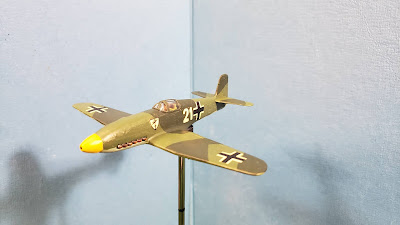One can almost feel the hand of Divine Guidance when one contemplates pattern of the decisions of the Nazi High Command during World War Two. The aircraft development process comes to mind, a few different decisions could have changed the course of the war. Most folks are familiar with the mania for dive bombing that lead to the regrettable HE-177 (a four engine heavy DIVE bomber) or the conversion of the ME-262 from a fighter into a fast bomber (never mind the Arado 234 fast bomber already in development at the same time). These decisions deprived the Luftwaffe of crucial, potentially war-winning, aircraft at critical junctures during the war.
Then there are some far less well known missed opportunities. The Heinkel HE-100 is a perfect example; a replacement for the far less successful HE-112 the HE-100 lost out to the Messerschmidt Bf-109 despite significantly better performance, easier ground-handling and nearly twice the range. Mostly because some Armani-suit wearing Nazi drug addict had decided that Messerschmidt made fighters while Heinkel made bombers, and it was just too confusing if things changed. Imagine (to your horror) how the Battle of Britain would have ended if the Luftwaffe had fighters with an extra hour of loiter-time over England, and that those fighters (lazily circling the R.A.F. bases) were better than the Spitfires they had come to hunt.
In another bout of irrational behavior the Luftwaffe decided that building rocket powered gliders was the way to stop the Allied bombing of Germany. The Messerschmidt ME-163 looks like a cross between a bat and a bullet. It proved to be an incredibly complicated (and dangerous to its pilots) way of getting a couple of cannon into the air for a pass or two of shooting at our bombers. The fuel was so dangerous that one of the pilots was dissolved because of a leak and more were blown up or burned due to explosions and fires during landing the plane (which had to be dead-sticked because the rocket had burned out). Unironically named the Komet this little number was almost impossible to intercept but fell victim to wide-ranging Allied fighters that would shoot it down as it glided in for a landing, or simply shot them up on the ground after they had landed.
An example of the Luftwaffe finally getting their thinking straight, thankfully far too late in the war to make a difference, the HE-162 was a light, simple to manufacture, inexpensive fast jet fighter of a very advanced design. Faster than any piston-driven fighter, armed with two 20mm cannon and considered a sweetheart of an aircraft by both the German pilots that flew them and the Allied test pilots after the war this "Volksjager" could have made a real difference in the air-war over Germany if only the Germans hadn't spent so much time and energy on the complicated and balky ME-262. Fortunately it took until September of 1944 for the Nazis to figure out that they needed an aircraft like this and the first example didn't take to the air until December 6th 1944.
























The Salamander (HE-162) is my favorite plane of WWII. I love that the pilot flew lying on his belly and if memory serves the "ejection" system, dropped the pilot out the bottom like a bomb. It always amazed me that no one (Commies I am talking to you) latched onto this thing and amped it up for the post war world. At a max speed of 562 mph it was ever so slightly faster than an ME 262 and had almost as great an endurance (40 miles less). And did it all on about 1/3 the fuel (695 liters in the 162 vs 2000 liters in the 262.
ReplyDelete